3
Section One: The Fundamentals
A) Keywords
Exercise 1:
Briefly (in 100 words or less) define one of the keywords in the padlet (including one that you. may have added yourself).
| Racial Hierarchies: The reflection and reinforcement in colonial sports of white athletes as the standard of health and fitness, limiting the participation of non-white athletes, and perpetuating stereotypes of racial inferiority. Historically, sports have upheld racial divisions, creating racial hierarchies in sport.
Colonial Sport: The continued influence of colonialism on sports, shaping participation and representation patterns and contributing to identity issues, cultural dominance, social control and Western propaganda. There is a need for the reclamation of sports traditions, challenging Western dominance through the decolonization of sports.
Intersectionality: When a person faces multiple systematic disadvantages and/or discrimination based on multiple aspects of their identity.
|
B) Representing Race
Exercise 2: Notebook Prompt
In about 50-70 words, consider Joel Bervell’s question: why do we feel the need to extrapolate the athleticism of one Black athlete to all Black people when we do not do the same for white athletes?
Try to think of examples when this happens, making sure to reflect on your own positionality.
Substitute Prompt: What does Shropshire propose as a solution to this problem?
Shropshire examines what we can do about the underrepresentation of African Americans in top-level positions in sports organizations. He reflects on his analysis of this subject from 25 years ago to the present day where not much has changed in terms of representation, “almost uniformly” (Shropshire). He examines how he previously thought that the solution was to build systems, rules and laws that forced change into this organizations but has found that these rules are rarely followed and systematically ignored. Instead, Shropshire reflects now how the solution really involves, acknowledging the existence of racism and discrimination, the usage of affirmative action, and achieving eventually true multiculturism. However, his main takeaway from the lack of change is that racism is so ingrained that in order for real change to happen, the hearts and minds of decision-makers must change. When they do, they will realize the benefits of a diverse organization and the benefits that brings.
|
C) Gender, Race & Sport
Exercise 3: Notebook Prompt
What are some strategies for resistance that Rajack and Joseph identify in their article as a means of pushing back against and resisting misogynoir?
| Rajack and Joseph identify how in order to push back against things such as colorism and resisting misogynoir, include subscribing journalists to report with a more nuanced critique. What this means is that journalists are not taking the full niche experiences of minority groups when reporting of them, and this contributes to a cycle of racist and sexist tropes in the media. They believe that online spaces and digital communities can create new opportunities of representations that encompass wider ranges of perspectives, which serve as counter-narratives and shift ideological control away from the current prominent storytellers.
|
Section Two: Making Connections
A) Athlete Activism
Exercise 3: Padlet Prompt
Do athletes have a responsibility to use their platform for social change? Why or why not? Please remember to record your response in both the padlet below and in your Notebook.
B) Athlete Activism & Feminism
Exercise 4: Complete the activities
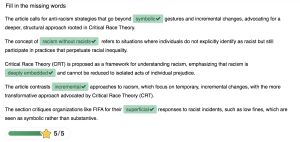

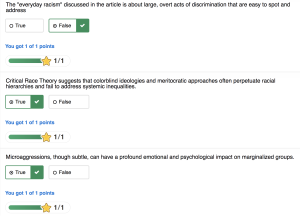
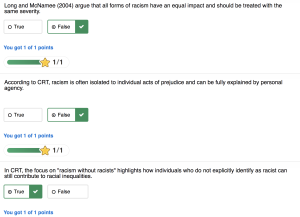
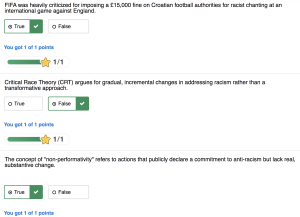
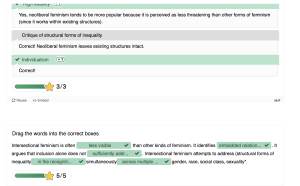
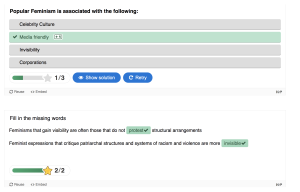
Exercise 5: Notebook Prompt
What do the authors of the article call for as a way of challenging how mainstream sports journalism privileges neoliberal feminist concerns? (100 words max.)
| A way of challenging privileged concerns would be telling stories differently from the commonly pushed dominant stories that serve the mainstream narrative. The feminisms that gain visibility are those that do not disrupt structural arrangements, so a way to challenge this would be examining the visibility patterns and making note who the source in which they stories are coming from.
|
C) Corporate social justice
Exercise 6: Padlet Poll
|
The contrasting stances on athlete activism between the NFL and the NBA are due to a few reasons. To begin, the NFL is larger in size, and with a larger size, there is a greater deal of money circulating, and it has been seen how people making decisions from a high money-generating level, are also those that distance themselves from the culture, and thus have poor response in cultural movements, even within their own organizations. As well, a further reasoning for the discrepancies, involve how the organizational dynamics of the NFL is worried about how they might be represented if involved as heavily in cultural movements due to their viewership. While the NBA has a diverse viewership, the NFL has a majority of white viewers, and this most definitely is a reason for the corporation in hesitating to align themselves in any way in fear of poor viewership response. The NFL’s lack of response is a business decision, and for these reasons, I believe that they failed in their responsibility as a corporation that both employs a large number of African-American players, and is an influential institution that cannot separate themselves from that.
|
Section Three: Taking a shot
Module Assignment (submit as part of notebook and separately through Blackboard mini assignment #1 portal)
In your Notebook, analyze the representation of a racialized athlete activist in a show (television or film or novel) of your choosing.
In recent years, the critically acclaimed and Oscar-winning movie “King Richard” portrayed the story of the early years of tennis prodigies, Venus and Serena Williams. Tennis was, and is, a prominently white sport. There were no black people in the country clubs, and black athletes were regarded as the ‘other’, and did not fit the mold or standard of white athletics. Social justice is where every group is valued and affirmed and that was definitely not the case for the Serena sisters. Upon living in this world, their father Richard knew that as two young black girls, with any other coach other than himself, they would not be treated with the same respect and expectations. They would not follow Rawl’s belief in each person to have an equal right to the most extensive total system, because at the time, this thought process for two young black girls was laughable. Some strategies used to speak out against these discriminations in the film include moving with grace and dignity, despite these discriminations. Sometimes action, and specifically non-action in this case, speaks louder than words. We can see this further reflected in Kenneth Shropshire’s account about how over the span of 25 years, not much has changed in regards to African American representation in sports. He specifically speaks on unconscious racism, which was evident across the film through the ways in which the sisters were portrayed in the media with constant attention towards their blackness. As well, it is seen in both the film and Stropshire’s account, how the media can contribute to the notion of interest convergence. This concept pulls together economic, psychology and public policies in the interest of recognizing the benefits of a diverse workforce or organization. This is seen through how Serena, Venus and Richard all represent by the end, a force of unrelenting nature, breaking down presumptions and prejudices. Throughout society, this created rippling effects that are not to be overlooked. That is why interest convergence perfectly represents the astounding effects that the Williams sisters sent through the world of sports.
Works Cited
Shropshire, Kenneth L. “Can Critical Race Theory Save Pro Sports?” The Philadelphia Citizen, 27 Oct. 2021, thephiladelphiacitizen.org/can-critical-race-theory-save-pro-sports.
Green, Reinaldo Marcus, et al. King Richard. Widescreen ed. [Burbank, CA], Warner Bros. Entertainment, 20222021.

